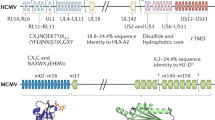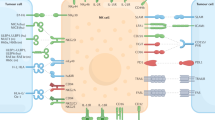Abstract
Investigations of cellular cytotoxicity of the immune system are hampered by the lack of continuously growing, transformed cell lines which express a cytotoxic potential. Here we describe cytotoxic cell lines from the cotton-topped marmoset monkey, transformed by Herpesvirus Ateles (HVA) or Herpesvirus Saimiri (HVS), which can kill certain target cells in a short-term in vitro test. HVA/HVS-transformed cells have earlier been classified as belonging to the T-cell lineage1–3 in contrast to Epstein–Barr virus (EBV)-transformed cells derived from B lymphocytes4. We suggest that the HVA/HVS-transformed killer cell lines described here represent an effector population resembling, or corresponding to, marmoset natural killer (NK) cells and that they may be used to define the cytolytic mechanism involved in cellular cytotoxicity and possibly also effector cell receptors and target cell antigens, as well as regulatory mechanisms of general biological interest.
This is a preview of subscription content, access via your institution
Access options
Subscribe to this journal
Receive 51 print issues and online access
$199.00 per year
only $3.90 per issue
Buy this article
- Purchase on Springer Link
- Instant access to full article PDF
Prices may be subject to local taxes which are calculated during checkout
Similar content being viewed by others
References
Deinhardt, F. & Deinhardt, J. in The Epstein-Barr Virus (eds Epstein, M. A. & Achong, B. G.) 373–415 (Springer, New York, 1979).
Falk, L., Wright, J., Wolfe, L. & Deinhardt, F. Int. J. Cancer 14, 244–251 (1974).
Falk, L., Johnson, D. R. & Deinhardt, F. Int. J. Cancer 21, 652–657 (1978).
Miller, G. in The Epstein-Barr Virus (eds Epstein, M. A. & Achong, B. G.) 351–372 (Springer, New York, 1979).
Minowada, J., Ohnuma, T. & Moore, G. E. J. natn. Cancer Inst. 49, 891–895 (1972).
Jondal, M. & Pross, H. Int. J. Cancer 15, 596–605 (1975).
Ono, A., Amos, D. B. & Koren, H. S. Nature 266, 546–548 (1977).
Möller, G. (ed.) Immun. Rev. 44 (1979).
Jondal, M., Spina, C. & Targan, S. Nature 272, 62–64 (1978).
Kiessling, R., Klein, E. & Wigzell, H. Eur. J. Immun. 5, 112–117 (1975).
Grimm, E. A., Thoma, J. A. & Bonavida, B. J. Immun. 123, 2870–2877 (1979).
Bonnard, G. D., Ysaka, K. & Maca, R. D. Cell. Immun. 51, 390–401 (1980).
Möller, G. (ed.) Immun. Rev. 51 (1980).
Massuci, M. G., Klein, E. & Argov, S. J. Immun. 124, 2458–2463 (1980).
Klein, E. Immun. Today 1, 4–6 (1980).
Ullberg, M. & Jondal, M. J. exp. Med. 153, 615–628 (1981).
Ullberg, M., Merrill, J. & Jondal, M. Scand. J. Immun. (in the press).
Berke, G. Prog. Allergy 27, 69–116 (1979).
Author information
Authors and Affiliations
Rights and permissions
About this article
Cite this article
Johnson, D., Jondal, M. Herpesvirus-transformed cytotoxic T-cell lines. Nature 291, 81–83 (1981). https://doi.org/10.1038/291081a0
Received:
Accepted:
Issue Date:
DOI: https://doi.org/10.1038/291081a0
This article is cited by
-
Learning noncoding RNA biology from viruses
Mammalian Genome (2022)
-
Expression of the collagen-like putative oncoprotein ofHerpesvirus saimiri in transformed T cells
Virus Genes (1993)
-
Understanding natural killer cells
Nature (1981)
Comments
By submitting a comment you agree to abide by our Terms and Community Guidelines. If you find something abusive or that does not comply with our terms or guidelines please flag it as inappropriate.



